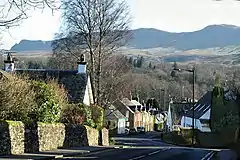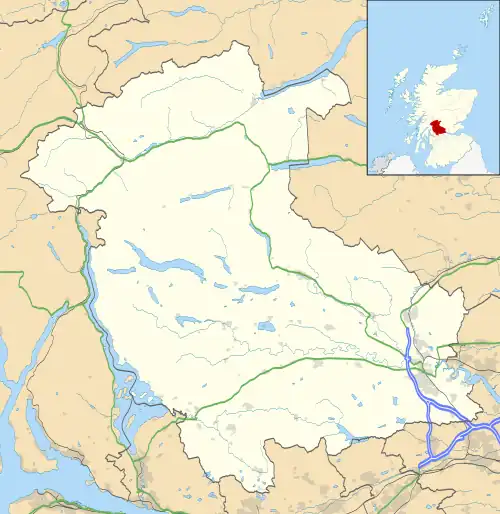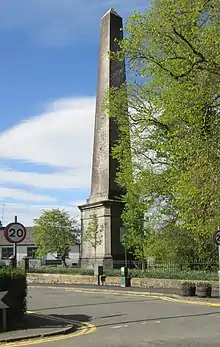Killearn
Killearn (Scottish Gaelic: Cill Fhearann, from orig. Ceann Fhearann, "Head/End of (the) Land/Territory" – until the 15th century when Ceann was replaced by Cill; denoting the presence of a house of worship)[2] – is a small village of approximately 1700 people in the Stirling council area of Scotland.
Killearn
| |
|---|---|
 Main street in Killearn | |
 Killearn Location within the Stirling council area | |
| Population | 1,910 (mid-2020 est.)[1] |
| OS grid reference | NS522860 |
| • Edinburgh | 50 mi (80 km) |
| • London | 400 mi (650 km) |
| Civil parish |
|
| Council area | |
| Lieutenancy area | |
| Country | Scotland |
| Sovereign state | United Kingdom |
| Post town | Glasgow |
| Postcode district | G63 |
| Dialling code | 01360 |
| Police | Scotland |
| Fire | Scottish |
| Ambulance | Scottish |
| UK Parliament | |
| Scottish Parliament | |
The village has its own primary school,[3] a local Co-Op store, a pre and post school club - The Little Outdoor Classroom, and two nurseries - Mulberrybush Montessori and Heron House[4]
The village is approximately 15 miles (24 kilometres) north of Glasgow, 7 miles (11 kilometres) east of Loch Lomond, and sits on the northwest flank of the Campsie Fells, most predominantly in the shadow of the volcanic plug of Dumgoyne, overlooking the confluence of the Endrick Water and Blane Water.
The Glengoyne whisky distillery, Loch Lomond and the Trossachs National Park and West Highland Way long-distance walking route are situated close to the village.
The residential special school of Ballikinrain is also located in Killearn Parish, and caters for boys with special needs from throughout Scotland. (The school has been earmarked for closure in July 2015).
The Church of Scotland congregation at Killearn Kirk falls under the Presbytery of Stirling, within the Synod of Forth. Within the Roman Catholic Church, Killearn falls under the Parish of Saint Anthony within the Roman Catholic Archdiocese of Saint Andrews and Edinburgh; although the Catholic community in Killearn is served by St. Anthony's Church in the neighbouring town of Balfron.
George Buchanan

Killearn was the birthplace of the historian and humanist scholar George Buchanan, (February 1506 – 28 September 1582). Buchanan belonged to the Monarchomach movement, which advocated of a form of popular sovereignty. Born at The Moss, Killearn, a monument, (Obelisk), at the centre of the village is dedicated to Buchanan.
References
- "Mid-2020 Population Estimates for Settlements and Localities in Scotland". National Records of Scotland. 31 March 2022. Retrieved 31 March 2022.
- Knight R."What's in a Name" (August 2014) (pdf) Killearn Courier, (Issue 29, Page 21). Retrieved 24 November 2014.
- "Killearn Primary School". sc-public.azurewebsites.net. Retrieved 17 September 2020.
- www.daynurseries.co.uk https://www.daynurseries.co.uk/daynursery.cfm/searchazref/50006014BEEB. Retrieved 17 September 2020.
{{cite web}}: Missing or empty|title=(help)